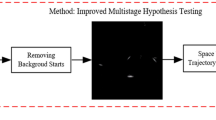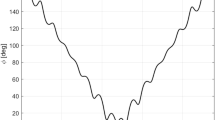Abstract
In view of the increasing threat of massive satellites and orbital debris to space launch missions, an optimization method of ground-based optoelectronics surveillance system is proposed. Passive optical system can monitor space target at a cost-effective way. This paper analyzes the detection ability of telescope and the optical reflection characteristics of high orbital objects, combined with the motion characteristics and observation conditions of high orbital debris, and thus analyzes the detection and recognition ability of space targets by the ground optoelectronics system. In order to solve the problem of faint targets detection, the optimization principle of star image with low signal-to-noise ratio (SNR) is demonstrated. Compared with the traditional frame difference method, the spatial targets with SNR greater than 3.10 can be identified without changing the aperture of observation equipment.
Similar content being viewed by others
References
Luo Hao, Mao Yin-dun, Yu Yong and Tang Zheng-hong, Opto-Electronic Engineering 44, 418, (2017). (in Chinese)
Wang Xue-yao, Spacecraft Engineering 27, 86, (2018). (in Chinese)
Wang Min, Automatic Recognition of Space Targets in Complex Background, Changchun Institute Optics, Fine Mechanics and Physics, Chinese Academy of Science, 2017. (in Chinese)
T. Flohrer, T. Schildknecht and R. Musci, Advances in Space Research 02, 1010, (2008).
Li Bin, Researches on Key Technologies of Fast and Accurate Orbit Determination and Prediction of Space Debris, Wuhan University, 2017. (in Chinese)
S. H. Craig and B. Greene, The EOS Space Debris Tracking System, The Advanced Maui Optical and Space Surveillance Technologies Conference, 2006.
Tan Ji-bo, Huang Jian-yu, Wang Kun-peng and Wu Wen-tang, Acta Photonica Sinica 46, 96, (2017). (in Chinese)
J. Stupl, N. Faber, C. Foster, F. Yang and B. Nelson, Light Force Photon-pressure Collision Avoidance: Updated Efficiency Analysis Utilizing a Highly Parallel Simulation Approach, AMOS: Advanced Maui Optical and Space Surveillance Conference, 2014.
T Flohrer, T Schildknecht, R. Musci and E. Stoveken, Advances in Space Research 03, 1226, (2005).
James R. Shell, Optimizing Orbital Debris Monitoring with Optical Telescopes, Advanced Maui Optical & Space Surveillance Technologies Conference, 2010.
Pascal Richard, Simulation of Telescope Detectivity for GEO Survey and Tracking, Proceedings of the Advanced Maui Optical and Space Surveillance Technologies Conference, 2014.
G. Kirchner, F. Koidl, F. Friederich, I. Buske and U. Volker, Advances in Space Research 51, 21, (2013).
P. Dao, R. Rast, W. Schlaegel, V. Schmid, S. Gregory and A. Dentamaro, Track-before-detect Algorithm for Faint Moving Objects Based on Random Sampling and Consensus, In Proceedings of the 2014 Advanced Maui Optical and Space Surveillance Technologies Conference, 2014.
M. Uetsuhara and N. Ikoma, Faint Debris Detection by Particle Based Track-before-detect Method, In Proceedings of the 2014 Advanced Maui Optical and Space Surveillance Technologies Conference, 2014.
W Krag, Visible Magnitude of Typical Satellites in Synchronous Orbits, Massachusetts: Massachusetts Institute of Technology, 1974.
Author information
Authors and Affiliations
Corresponding author
Additional information
This work has been supported by the Third Phase of Innovative Engineering Projects of Changchun Institute of Optics, Fine Mechanics and Physics, Chinese Academy of Sciences (No.065X32CN60).
Rights and permissions
About this article
Cite this article
Gao, Y., Zhao, Jy. Space object detecting ability improvement method based on optimal principle. Optoelectron. Lett. 15, 459–462 (2019). https://doi.org/10.1007/s11801-019-8204-4
Received:
Revised:
Published:
Issue Date:
DOI: https://doi.org/10.1007/s11801-019-8204-4




